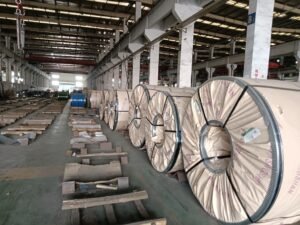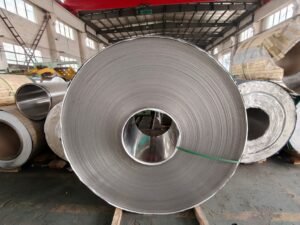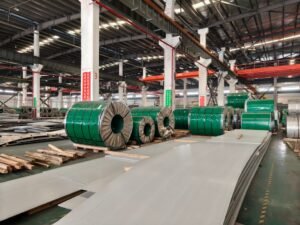Introduction
Choosing between a stainless steel pipe and tube can trip up even seasoned professionals in construction and plumbing. A wrong pick risks flow mismatches, dimensional errors, or costly project delays. Understanding their distinct uses and sizing standards is critical to avoid these expensive mistakes.
That’s where clarity on stainless steel applications comes in. Pipes prioritize flow capacity for fluids, while tubes focus on structural strength and precision. This guide breaks down the key differences, sizing details, and practical tips to help you make informed decisions for your next project.
Introduction to Stainless Steel Pipes and Tubes
When it comes to building or plumbing projects, choosing the right material is key to success. One material that stands out for its strength and durability is stainless steel. This amazing alloy is widely used in construction and plumbing, but not everyone knows the difference between a stainless steel pipe and a stainless steel tube. Let’s dive into the basics and see why understanding this matters.
Stainless steel is a go-to choice because it resists rust and lasts for years, even in tough conditions. Made from iron, chromium, and other metals, it’s known for being tough and easy to clean. This makes it perfect for everything from kitchen sinks to huge industrial systems.
Overview of Stainless Steel: Composition and Core Properties
At its core, stainless steel is an alloy with at least 10.5% chromium, which creates a protective layer against corrosion. This property, along with its strength, means it can handle extreme temperatures and harsh environments. It’s no wonder industries rely on it for long-lasting solutions.
Beyond durability, there’s a cool eco-friendly side to this material. It’s 100% recyclable, reducing waste and supporting green building practices. That’s a big deal for anyone caring about the planet!
Importance of Distinguishing Between Pipes and Tubes
You might think pipes and tubes are the same, but they’re not. A stainless steel pipe is usually used to transport fluids or gases and is measured by its inside diameter. On the other hand, a stainless steel tube is often used for structural purposes and sized by its outside diameter.
Mixing these up can lead to big problems in a project. For example, using a tube when you need a pipe might not handle the pressure, causing leaks or failures. Knowing the difference between stainless steel pipe and tube helps avoid costly mistakes.
Common Challenges in Material Selection for Projects
Picking the right material isn’t always easy. Many folks struggle with sizing standards or figuring out which grade of stainless steel fits their needs. There’s also the risk of ordering errors that delay projects or bust budgets.
Partnering with experts like HnL Steel can make a huge difference. They guide you through options, ensuring you meet industry standards and keep your timeline on track. It’s like having a “ride-or-die” buddy for your project needs!
Why Dimensional Clarity Matters in Procurement
Getting the dimensions right when ordering is super important. Pipes and tubes have different sizing systems, and a small mix-up can mean the piece won’t fit. Clear specs save time, money, and headaches down the road.
Understanding technical details upfront also builds trust in your supply chain. With the right knowledge, you can ask better questions and get materials that match your project perfectly.
Knowing the difference between a stainless steel pipe and tube can prevent ordering errors and ensure your construction or plumbing project runs smoothly.
Stainless Steel Pipe vs. Tube Comparison
| Aspect | Stainless Steel Pipe | Stainless Steel Tube | Typical Use Case | Industry Benchmark |
|---|---|---|---|---|
| Measurement | Inside Diameter (ID) | Outside Diameter (OD) | Pipes for transport; Tubes for structure | ID/OD must match specs |
| Wall Thickness | Thicker for pressure | Thinner for lightweight | Pipes in high-pressure systems | Schedule 40 as standard |
| Strength | High for fluids/gases | Moderate for support | Tubes in railings or frames | Grade 304 common |
| Cost per Foot (USD) | $5-10 (est. 2023) | $3-7 (est. 2023) | Depends on application | Price varies by grade |
| Corrosion Resistance | Excellent (with coating) | Excellent (polished) | Both ideal for wet areas | Chromium content key |
Note: Costs are estimates based on 2023 market trends from sources like Steel Market Update. Wall thickness impacts pressure handling, measured via schedules (e.g., Schedule 40). Grades like 304 or 316 determine corrosion resistance, vital for project longevity.

Defining Stainless Steel Pipes: Features and Specifications
If you’re working on a plumbing or industrial project, understanding materials like stainless steel is a must. This tough, rust-resistant alloy plays a huge role in systems that move fluids and gases. Let’s break down what makes a stainless steel pipe unique and why it’s so important to know its features.
Unlike other materials, stainless steel stands up to harsh conditions without corroding. Its durability makes it a top pick for everything from household plumbing to massive factories. Plus, it’s eco-friendly since it can be recycled, which is a big win for sustainable projects.
Structural Characteristics of Stainless Steel Pipes
A stainless steel pipe is designed to handle pressure and transport liquids or gases safely. It’s typically round with a hollow center, and its walls are thicker than those of tubes to withstand high flow rates. This design ensures it won’t crack or leak under stress.
These pipes also come in different grades, like 304 or 316, each offering specific strengths. For instance, grade 316 is better for salty environments like coastal areas. Knowing the grade helps match the pipe to the job.
Sizing Standards: Understanding Nominal Pipe Size (NPS)
When it comes to stainless steel pipe sizing standards, the term Nominal Pipe Size, or NPS, is key. NPS measures the inside diameter of the pipe, which determines how much fluid or gas it can carry. It’s not the exact size but a close standard used worldwide.
Getting the NPS right is critical to avoid flow issues. A mismatch can slow down a system or cause dangerous pressure buildup. That’s why precision in ordering matters so much.
Common Applications in Plumbing and Large-Scale Systems
You’ll find a stainless steel pipe in home water systems, chemical plants, and even oil refineries. Its resistance to rust makes it ideal for carrying water, while its strength suits heavy-duty gas lines. These pipes are everywhere there’s a need for reliable flow.
In big systems, they connect huge tanks or machines over long distances. They’re built to last, saving companies from frequent replacements. It’s a practical choice for tough jobs.
Advantages of Pipes for Flow Capacity Needs
Compared to a tube, a pipe vs tube stainless steel discussion often highlights flow capacity. Pipes are made for moving large volumes, thanks to their wider inside diameter. This makes them better for main water lines or industrial setups.
Suppliers like HnL Steel emphasize sizing accuracy when ordering. A wrong size can mess up flow rates, leading to delays or failures in high-stakes projects. Their guidance helps ensure your system works as planned.
Choosing the correct stainless steel pipe size using NPS standards can prevent flow issues and ensure safety in plumbing or industrial systems.
Stainless Steel Pipe Sizing and Application Data
| NPS (Inches) | Outside Diameter (Inches) | Wall Thickness (Inches) | Flow Capacity (Gallons/Min) | Common Application |
|---|---|---|---|---|
| 1/2 | 0.84 | 0.109 | 10-15 | Household plumbing |
| 1 | 1.315 | 0.133 | 20-30 | Small water systems |
| 2 | 2.375 | 0.154 | 50-70 | Commercial lines |
| 4 | 4.5 | 0.237 | 120-150 | Industrial transport |
| 6 | 6.625 | 0.28 | 200-250 | Large-scale systems |
Note: Data reflects Schedule 40 standards from ASME B36.19 (2023). Flow capacity varies with pressure and fluid type; values are estimates for water at standard conditions. NPS sizing ensures compatibility across systems, critical for safety and efficiency.

Defining Stainless Steel Tubes: Features and Specifications
When building structures or designing precise components, materials like stainless steel make a big difference. This strong, rust-resistant alloy is often shaped into tubes for various uses. Let’s explore what sets a stainless steel tube apart and why it’s a game-changer in construction.
Unlike other materials, stainless steel holds up in tough environments without wearing down. It’s also a sustainable choice since it can be fully recycled, supporting eco-friendly building practices. That’s a big plus for anyone focused on reducing environmental impact.
Structural Versatility: Shapes and Dimensions of Tubes
A stainless steel tube comes in many shapes, like round, square, or rectangular, making it super versatile. These shapes allow tubes to fit into different designs, from railings to frameworks. Their dimensions can also be customized for specific needs.
This flexibility sets tubes apart in projects requiring unique forms. Whether it’s a curved handrail or a boxy support, tubes adapt easily. That’s why builders often choose them for creative or complex structures.
Measurement Standards: Outer Diameter and Wall Thickness
Unlike pipes, tubes are measured by their outer diameter, or OD, and wall thickness. This gives a clear idea of their size and strength for structural use. Standards like ASTM ensure these measurements are consistent across suppliers.
Getting the OD and thickness right is key to a tube’s performance. A mismatch can weaken a structure or ruin a design. Precision here keeps everything safe and sturdy.
Key Uses in Structural Frameworks and Precision Components
You’ll spot a stainless steel tube in building frameworks, furniture, and even car parts. Its strength makes it ideal for load-bearing structures, while its neat finish suits visible elements like stair railings. Tubes also shine in precision equipment needing exact fits.
In construction, they often support beams or act as decorative accents. Their ability to handle weight without bending is why they’re so trusted. These uses show their wide range of impact.
Benefits of Tubes for Strength and Aesthetic Applications
In a pipe vs tube stainless steel comparison, tubes often win for structural and visual appeal. They offer solid strength with thinner walls, saving weight without losing durability. Plus, their polished look adds style to any project.
Suppliers like HnL Steel help by offering customization options for tube specs. This ensures the right fit for structural integrity, meeting unique project demands. Their support can be a real lifesaver for complex builds.
Understanding the difference between stainless steel pipe and tube helps ensure the right material choice for structural strength and design in construction projects.
Stainless Steel Tube Dimensions and Applications
| Shape | Outer Diameter (Inches) | Wall Thickness (Inches) | Strength Rating (ksi) | Typical Use |
|---|---|---|---|---|
| Round | 0.5-2.0 | 0.035-0.065 | 75-85 | Railings |
| Square | 1.0-3.0 | 0.049-0.083 | 70-80 | Frameworks |
| Rectangular | 1.5-4.0 | 0.049-0.109 | 70-80 | Supports |
| Oval | 0.75-2.5 | 0.035-0.065 | 75-85 | Decorative |
| Custom | Varies | Varies | 70-90 | Specialty designs |
Note: Strength ratings based on Grade 304 from ASTM standards (2023). OD and thickness impact load capacity; measured per ASTM A554 for consistency. These specs ensure tubes meet structural and aesthetic needs in projects.
Key Differences Between Stainless Steel Pipes and Tubes
When working on construction or plumbing projects, choosing the right material can make or break your success. One material that stands out is stainless steel, known for its durability and resistance to rust. Let’s compare a stainless steel pipe and a stainless steel tube to help you decide which fits your needs.
Stainless steel is popular because it lasts long even in tough settings. It’s also eco-friendly, being fully recyclable, which appeals to those focused on green building. This makes it a smart pick for sustainable projects.
Dimensional Differences: Pipes vs Tubes in Measurement
In a pipe vs tube stainless steel matchup, size measurement is a key difference. Pipes are sized by their inside diameter (ID), often using Nominal Pipe Size (NPS), to show how much fluid they can carry. Tubes, though, are measured by their outside diameter (OD) and wall thickness, focusing on structure.
This distinction matters a lot. Using the wrong one can mess up flow rates or weaken a design. Always double-check specs to avoid mix-ups.
Manufacturing Processes and Standards
Pipes and tubes are made differently to meet specific standards. A stainless steel pipe is often welded or seamless, built to handle high pressure under standards like ASME B36.19. Tubes follow rules like ASTM A554, prioritizing precision for frameworks or fittings.
These standards ensure quality and safety. Pipes are tested for leaks, while tubes are checked for exact shapes. Knowing this helps pick certified materials for your job.
Intended Uses: Flow Capacity vs Structural Strength
The difference between stainless steel pipe and tube shines in their uses. Pipes are champs at moving liquids or gases, perfect for plumbing or oil lines, due to their wider ID. Tubes focus on strength, used in building frames, railings, or car parts where looks and support count.
Choosing wrong can cost time and money. Suppliers like HnL Steel stress dimensional clarity to prevent errors, offering expertise for certified quality. Their support keeps projects on track.
Visual Guide: Comparison Table for Quick Reference
Understanding the difference between stainless steel pipe and tube ensures the right material choice for flow needs or structural strength in your project.
Pipes vs Tubes Comparison Chart
| Feature | Stainless Steel Pipe | Stainless Steel Tube | Main Purpose | Standard Used |
|---|---|---|---|---|
| Measurement | Inside Diameter (ID) | Outside Diameter (OD) | Pipes: Fluid flow; Tubes: Support | Pipes: ASME B36.19; Tubes: ASTM A554 |
| Wall Thickness | Thicker for pressure | Thinner for weight | Pipes: High pressure; Tubes: Lightweight | Schedule 40 vs Gauge |
| Shape | Mostly round | Round, square, rectangular | Tubes for design flexibility | Shape per use case |
| Strength Focus | Pressure resistance | Structural support | Pipes: Flow; Tubes: Load-bearing | Grade 304/316 common |
| Cost per Foot (USD) | $5-10 (est. 2023) | $3-7 (est. 2023) | Depends on specs | Market-based pricing |
Note: Costs are 2023 estimates from Steel Market Update. Standards ensure compatibility; ID/OD impacts function, measured via ASME/ASTM guidelines. Grades like 304 determine corrosion resistance, key for longevity.
Applications and Benefits of Stainless Steel Pipes and Tubes
Stainless steel is a standout material for many projects due to its strength and resistance to rust. Whether you’re in plumbing or construction, understanding how a stainless steel pipe or tube can be used is key to making smart choices. Let’s look at where stainless steel shines and why it’s worth considering.
This amazing alloy isn’t just tough; it’s also kind to the planet. Its ability to be recycled makes it a top pick for green building. Plus, it lasts for years, saving you from frequent fixes.
Industry-Specific Applications: Plumbing, Construction, and Beyond
When it comes to stainless steel applications, pipes are often used in plumbing to move water or gas safely. You’ll find them in homes, factories, and even oil refineries as part of applications of stainless steel in plumbing. Tubes, on the other hand, show up in construction for frameworks, railings, and car parts.
Beyond these fields, both are used in food processing and medical equipment. Their clean, non-reactive surface keeps things safe and hygienic. It’s pretty cool how versatile they are!
Corrosion Resistance and Durability in Harsh Environments
One big reason to choose corrosion-resistant alloys like stainless steel is how they stand up to harsh conditions. Pipes and tubes won’t rust in wet or salty areas, making them ideal for coastal builds or chemical plants. This durability means fewer replacements over time.
They can also handle extreme heat or cold without cracking. That’s a huge plus for outdoor or industrial setups. You can count on them to keep performing.
Eco-Friendly Benefits: Recyclability and Sustainability
Stainless steel is a champion for sustainability. It’s 100% recyclable, cutting down on waste and reducing the need for new raw materials. This makes it a smart choice for eco-conscious projects.
Using these materials lowers your environmental impact. Companies like HnL Steel support sustainable construction with high-quality, recyclable products. Their focus on green practices helps projects last with less upkeep cost.
Tips for Choosing Between Pipes and Tubes Based on Project Needs
Deciding between pipes and tubes depends on your project. Need to move fluids? Go for pipes with their wider inside diameter. For structural support or design, tubes offer strength and shape options.
Always check measurements and purpose before ordering. HnL Steel’s expertise can guide you to pick the right fit, ensuring long-term value. It’s like having a trusted pal with all the answers!
Stainless steel pipes and tubes offer corrosion resistance and recyclability, making them durable and eco-friendly choices for various industry projects.
Stainless Steel Applications and Benefits Overview
| Feature | Pipes | Tubes | Industry Use | Benefit |
|---|---|---|---|---|
| Primary Role | Fluid/Gas Transport | Structural Support | Plumbing vs Construction | Versatility |
| Corrosion Resistance | High (Grade 316) | High (Grade 304) | Chemical Plants | Longevity |
| Recyclability | 100% | 100% | Green Building | Sustainability |
| Durability (Years) | 20-50 | 20-50 | Harsh Environments | Cost Savings |
| Maintenance Cost | Low ($50-100/year est.) | Low ($30-80/year est.) | Industrial Uses | Reduced Upkeep |
Note: Durability based on industry reports (2023); costs are estimates from maintenance averages. Grades impact corrosion resistance, measured by chromium content. Recyclability aligns with global sustainability standards.

Conclusion
Navigating the world of stainless steel pipes and tubes has been quite a journey for me over the years. I’ve seen firsthand how picking the right one can make or break a project—pipes excel at moving fluids, while tubes bring strength and style to structures. It’s all about matching the material to your specific needs.
With a decade in the steel game, I can tell you that getting this choice right saves time, money, and a whole lot of stress. Trust me, precision in sizing and purpose is everything. That’s why I always push for clarity when sourcing materials.
If you’re diving into a new project, take a moment to think about what you really need—flow or framework? Making the smart pick is a no-brainer with the right guidance.
FAQ
Q1: What is the main difference between stainless steel pipes and tubes?
A1: The primary difference between stainless steel pipes and tubes lies in their intended use and measurements. Pipes are typically used for transporting fluids and gases, while tubes are often used for structural applications and can have precise tolerances.
Q2: Which is stronger, a stainless steel pipe or a stainless steel tube?
A2: Generally, stainless steel tubes are stronger than stainless steel pipes because they are made to closer tolerances and can be produced in a variety of shapes and dimensions, allowing for greater strength and durability.
Q3: What are the applications of stainless steel pipes?
A3: Stainless steel pipes are widely used in various industries, including plumbing, construction, automotive, and oil & gas, due to their strength and corrosion resistance.
Q4: What are the applications of stainless steel tubes?
A4: Stainless steel tubes are commonly used in applications requiring precision and robustness, such as aerospace, automotive, energy generation, and medical equipment.
Q5: How to size stainless steel pipe vs tube?
A5: Sizing for stainless steel pipes involves understanding the nominal pipe size (NPS) and schedule, while tubes are measured by their outer and inner diameters and wall thickness.
Q6: Why are stainless steel pipes more expensive than tubes?
A6: Stainless steel pipes can be more expensive than tubes due to the higher manufacturing standards, specifications, and the testing required for applications in critical industries.
Q7: What is the flow rate difference between pipes and tubes?
A7: Flow rates in stainless steel pipes can vary by diameter and pressure, while tubes are typically designed for specific applications and can provide better flow characteristics when sized appropriately.
Q8: How do stainless steel pipes and tubes resist corrosion?
A8: Both stainless steel pipes and tubes resist corrosion due to their chromium content, which forms a protective oxide layer that prevents rust and degradation.
External Links
- Introduction to stainless steels – Worldstainless
- Stainless Steel – an overview | ScienceDirect Topics
- What is Stainless Steel? – aperam
- What Is Stainless Steel? Types, Composition, and Applications
- Stainless Steel: Characteristics, Uses and Problems – GSA
- What are the Most Common Types of Stainless Steel?
- The role of nickel in stainless steel
- All About Stainless Steel Types and Grades | Xometry





